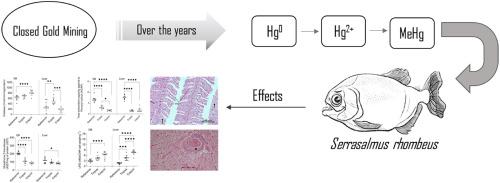Chemosphere ( IF 8.8 ) Pub Date : 2021-09-16 , DOI: 10.1016/j.chemosphere.2021.132263 Caroline da Silva Montes 1 , Maria Auxiliadora Pantoja Ferreira 1 , Tommaso Giarrizzo 2 , Lílian Lund Amado 3 , Rossineide Martins Rocha 1

|
Tapajós Region, is an area with intense historical artisanal and small-scale gold mining. Therefore, the core objective of this study was to evaluate the environmental status of different rivers located in this region, using biomarker endpoints in Serrasalmus rhombeus as a tool. Fish and sediment were collected from two rivers, Tropas and Crepori, affluent of Tapajós River, located inside a Federal Protection Area and in a Reference site. Mercury concentration in sediment and fish were traced, and biomarkers in gills and liver were analyzed. Results showed a clear difference between these two rivers compared to the Reference site. Fish tissues presented biomarker responses according to the site of collection. Catalase (CAT) activity was statistically higher in fish gills from Crepori, confirming the capacity of mercury interference with redox equilibrium. High levels of lipid peroxidation were also noted to contribute greatly in incidence of morphological changes in the liver and gills, suggesting that mercury bioaccumulation during continuous exposure promote biological responses in a cumulative manner, from molecules to tissues. This study also indicates adaptation in fish defense mechanisms given the conditions in the Tropas River, as well as a variation in biomarker responses to that of the Crepori river. In summary, Tapajós affluents presented high mercury levels in fish tissues leading to biomarker responses, demonstrating a hazardous signal of a long history of mercury pollution.
中文翻译:

亚马逊地区手工淘金的遗产及其对鱼类健康的影响:多生物标志物方法
塔帕若斯地区是一个历史悠久的手工和小规模金矿开采区。因此,本研究的核心目标是使用菱形锯齿藻的生物标志物终点评估位于该地区的不同河流的环境状况。作为工具。从位于联邦保护区内和参考地点的两条河流 Tropas 和 Crepori(Tapajós 河的富集河流)收集鱼类和沉积物。追踪沉积物和鱼类中的汞浓度,并分析鳃和肝脏中的生物标志物。结果显示,与参考站点相比,这两条河流之间存在明显差异。鱼类组织根据收集地点呈现生物标志物反应。来自 Crepori 的鱼鳃中的过氧化氢酶 (CAT) 活性在统计学上更高,证实了汞对氧化还原平衡的干扰能力。还注意到高水平的脂质过氧化对肝脏和鳃的形态变化发生率有很大影响,这表明连续接触期间汞的生物积累以累积的方式促进生物反应,从分子到组织。这项研究还表明,考虑到特罗帕斯河的条件,鱼类防御机制的适应性,以及生物标志物对克雷波里河的反应的变化。总之,Tapajós 富水在鱼组织中呈现出高汞含量,导致生物标志物反应,表明长期汞污染历史的危险信号。


























 京公网安备 11010802027423号
京公网安备 11010802027423号